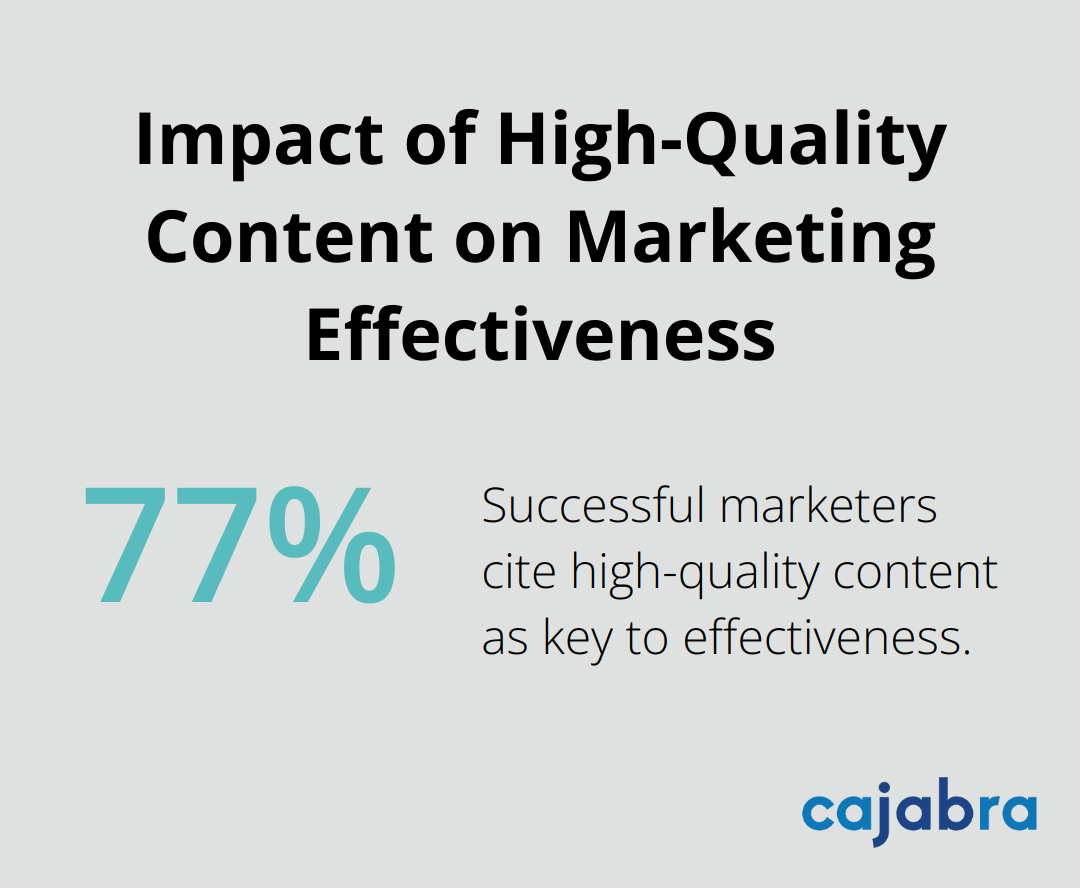
At Cajabra, LLC, we know that a solid content creation plan is the backbone of successful digital marketing.
Many businesses struggle to produce consistent, high-quality content that resonates with their audience and drives results. This guide will walk you through the essential steps to create an effective content plan that aligns with your goals and engages your target market.
By the end, you'll have the tools and knowledge to develop a strategy that boosts your online presence and delivers real value to your customers.
Understanding your audience forms the foundation of any successful content plan. Tailoring content to specific audience needs can dramatically boost engagement and conversions.
Start by creating detailed buyer personas. These are semi-fictional representations of your ideal clients based on market research and real data about your existing customers. Include demographics, behavior patterns, motivations, and goals. For example, if you're an accounting firm, your persona might be "Sarah, a 45-year-old small business owner who struggles with cash flow management and tax planning."
Use tools like Google Analytics to gather data on your existing audience. Look at metrics such as age, location, interests, and behavior on your website. This information can reveal surprising insights about who's actually engaging with your content.
Don't guess what your audience wants-ask them directly. Use surveys, interviews, or focus groups to understand their pain points, preferences, and content consumption habits. A study by the Content Marketing Institute found that 77% of successful marketers cite producing high-quality content as a key factor in their effectiveness.

Your content objectives should be SMART: Specific, Measurable, Achievable, Relevant, and Time-bound.
Try to create specific goals instead of vague ones. For example, "increase website traffic from organic search by 25% in the next six months" gives you a clear target to work towards and measure against (rather than a general goal like "increase brand awareness").
Your content objectives should directly support your broader business goals. If your business aim is to increase revenue by 20% this year, your content objectives might include:
An effective content plan isn't about producing more content-it's about producing the right content for the right audience at the right time. With a thorough understanding of your audience and clear, aligned objectives, you'll be ready to develop a content strategy that drives real results (which we'll explore in the next section).
Create a mix of content types to cater to different learning styles and preferences. Blog posts excel at in-depth explanations, while infographics simplify complex financial concepts. Video content, such as quick tax tips or client testimonials, can boost engagement significantly. HubSpot reports that 54% of consumers want to see more video content from brands they support.

A content calendar serves as your roadmap to consistent publishing. Tools like Trello or Asana help plan topics, assign tasks, and set deadlines. Try to balance timely content (like tax season tips) with evergreen material that provides value year-round. Schedule your content at least a month in advance to avoid last-minute scrambles.
Establish 3-5 core topics that align with your expertise and audience interests. For accounting firms, these might include tax planning, financial forecasting, and business advisory services. Build your content around these pillars to establish authority in your niche. A study by Edelman found that thought leadership is important in influencing B2B decision-makers' perception of an organization.
SEO extends beyond keywords; it focuses on creating valuable content that answers your audience's questions. Tools like SEMrush or Ahrefs help identify high-volume, low-competition keywords relevant to your content pillars. Incorporate these naturally into your titles, headers, and throughout your content. Don't forget to optimize meta descriptions and image alt text for better search visibility.
Encourage clients to share their experiences and success stories. User-generated content (UGC) adds authenticity to your brand and builds trust with potential clients. Consider featuring client testimonials, case studies, or even guest posts from satisfied customers. This approach not only provides social proof but also reduces your content creation workload.
The implementation of these strategies will help create a content plan that resonates with your audience and drives tangible business results. The next section will explore how to effectively implement your content strategy and measure its success.
The selection of appropriate content management tools can significantly impact the execution of your content plan. We recommend project management platforms like Asana or Monday.com to assign tasks, set deadlines, and monitor progress. These tools provide a visual representation of your content calendar and ensure clear responsibility allocation.
For content creation, AI-powered writing assistants (such as Jasper or Copy.ai) can accelerate the first draft process. However, human editors should always review and refine the content to maintain quality and brand voice consistency.
Assign specific roles within your content team. Designate a content strategist to oversee the big picture, writers to create the content, and editors to ensure quality and consistency. Even in smaller firms where individuals may wear multiple hats, clearly defining these roles helps maintain focus and efficiency.
Schedule regular check-ins to discuss progress, challenges, and new ideas. A study by the Project Management Institute revealed that organizations with high-performing project management practices complete 89% of their projects successfully (compared to 36% for low performers).

Effective measurement of your content plan's success extends beyond page view counts. Focus on metrics that align with your business objectives. For accounting firms, this might include:
Regular analysis plays a vital role in refining your content plan. Allocate time each month to review your performance metrics and identify trends. Look for content types or topics that consistently perform well and consider increasing focus on these areas.
Don't hesitate to experiment with new formats or topics. A/B testing different headlines, content lengths, or calls-to-action can provide valuable insights into what resonates with your audience.
Creating an effective content plan requires ongoing effort. Consistent implementation, measurement, and refinement of your strategy will help build a strong online presence that attracts and retains high-value clients for your accounting firm.
An effective content creation plan requires careful planning, execution, and continuous refinement. You must understand your audience, set clear objectives, and align your content with business goals. A diverse content strategy, SEO best practices, and user-generated content will amplify your reach and engagement.
The implementation phase demands the right tools, clear role assignments, and consistent monitoring of key performance indicators. You should produce high-quality, relevant content regularly to build trust with your audience and establish your brand as an authority in your field. The digital landscape evolves rapidly, so your content strategy should adapt to new trends, technologies, and audience preferences.
Don't let the process overwhelm you. Start small, focus on quality over quantity, and gradually expand your content efforts as you gain insights. At Cajabra, we help accounting firms develop and implement effective marketing strategies (including content plans that drive real results). Take the first step today: analyze your current content, identify gaps, and start crafting a content creation plan that aligns with your business objectives.



